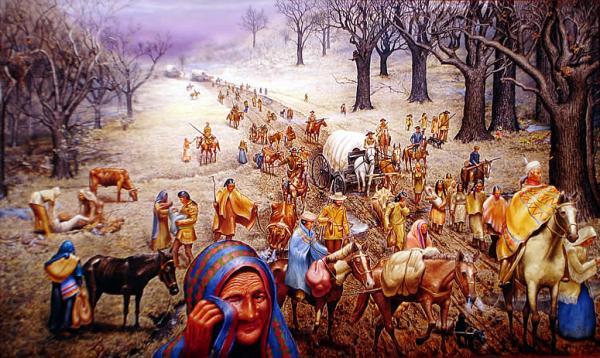 |
Canku Ota
|
 |
|
(Many Paths)
|
||
|
An Online Newsletter
Celebrating Native America
|
||
|
August 2017 - Volume
15 Number 8
|
||
|
|
||
|
Trail Of Tears: From
A Middle School Student's Perspective
|
||
|
by Indian Country Media
Network Staff
|
||
|
The Trail of
Tears set a national precedent for the confiscation of Indian lands
This persuasive essay was submitted to ICTMN by Matthew Scraper, Megan Scraper’s father. Megan, 12, is a student at Marlow Middle School in Oklahoma. They are citizens of the Cherokee Nation, and Matthew pointed out that their last name is an English translation of the Cherokee word "disugasgi," which means something along the lines of "the one who repeatedly scrapes the skin." She chose to write about the Trail of Tears on her own when given a class assignment. Imagine you are a little girl in the late 1830s. You and your family had lived in the Cherokee tribe for generations. Then one day when you returned from playing in the fields, you find your family gone and your house is ransacked. A short time later you get placed inside a cattle stockade, and after a few months you realize you’ll never see your family again. This is what happened to a lot of small kids on that dreadful day. It was painful for many Indians to watch their lands taken, the people die, and have to watch their people abused and mistreated. This was a very bad time for Native Americans. The Trail of Tears was the biggest crime against the indigenous population, the crime that wasn’t considered a crime. The Trail of Tears set a national precedent for the confiscation of Indian lands. What this means is it started the Removal Era, and later the Land Run Era that included land that had once been Cherokee without any respect for the people who lived there before. They wanted the land for a few reasons, but a couple are: farming, and belief in the existence of gold. They were told that it would only happen once, but it continued on with different tribes later, after it happened during the Trail of Tears. A fact you may not know is that the Trail of Tears represented the largest percentage of deaths within a single indigenous tribe due to the action of the U.S. government in American Indian history. This killed around 4,000 members of the Cherokee tribe. These people died because of lots of reasons: poor weather conditions, little food and water, long walks with little rest, sickness with no medicine, and lastly being killed by soldiers. This is a word that people use when someone tries to wipe out an entire race: genocide. That happened to these people, my people, it was very hard for them for many reasons, but they weren’t allowed to give their loved ones proper burial rites, they had to bury them on the side of the Trail and then just keep walking. Can you imagine having to bury a family member on the side of the road and then just having to leave them there? The deaths of these people, my people, were very hard on the Indians. The name of the Trail of Tears actually came from a Cherokee phrase that meant "the place where they cried." Lastly, the Trail of Tears set a precedent for the subhuman treatment of indigenous people by the U.S. government. This means that it justified the abusive treatment toward Indians. When they were gathered up in cattle stockades, in the mud with a bunch of diseases, many other things happened as well: women were raped, people were separated from their families, they were beaten, and they were killed. It wasn’t right and it wasn’t fair, but there was nothing the tribes could do. The soldiers were mean, cruel, and in my personal opinion, acted like the British soldiers did before America declared independence from Britain. The people were treated with disrespect, and one of the only reasons this happened was because the government decided that land and gold were more important than Indian lives. In conclusion, the people who were forced to undergo the Trail of Tears were treated with injustice. The Trail of Tears set a precedent for the confiscation of Indian lands, represented the largest percentage of deaths within a single indigenous tribe as a result of action taken by the U.S. government, and set a precedent for the subhuman treatment of Indian people by the U.S. government. These reasons support the opinion: The Trail of Tears was the biggest crime against the indigenous population, and after reading this essay you might be thinking, "I agree." Well, good. Now that you know this, take care and make sure that it never happens again. |
||
|
|
|
|
||
|
|
||
| Canku Ota is a free Newsletter celebrating Native America, its traditions and accomplishments . We do not provide subscriber or visitor names to anyone. Some articles presented in Canku Ota may contain copyright material. We have received appropriate permissions for republishing any articles. Material appearing here is distributed without profit or monetary gain to those who have expressed an interest. This is in accordance with Title 17 U.S.C. Section 107. | ||
|
Canku Ota is a copyright ©
2000 - 2017 of Vicki Williams Barry and Paul Barry.
|
||
 |
 |
|
|
The "Canku
Ota - A Newsletter Celebrating Native America" web site and
its design is the
|
||
|
Copyright ©
1999 - 2017 of Paul C. Barry.
|
||
|
All Rights Reserved.
|
||
